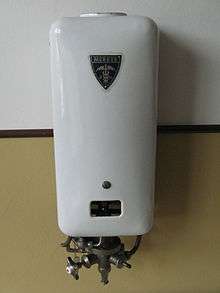Pilot light

A pilot light is a small gas flame, usually natural gas or liquefied petroleum gas, which serves as an ignition source for a more powerful gas burner. Originally, a pilot light was kept permanently alight; however, this is wasteful of gas. Now it is more common to light a burner electrically, but gas pilot lights are still used when a high energy ignition source is necessary, as in when lighting a large burner.
The term "pilot light" is also used occasionally for an electrical indicator light that illuminates to show that electrical power is available, or that an electrical device is operating. Such indicators were originally incandescent lamps or neon lamps, but now are usually LEDs.
Origin
During the American colonial period, people kept a small flame called a "pilot" burning in order to quickly light a fire for a fireplace or for a cooking stove.
Uses
Common applications include household water heaters, central heating systems, fireplaces, flamethrowers, and hot air balloons. While most commercial kitchens still rely on pilot lights for burners, ovens, and grills, current residential systems generally have an electrical ignition. This is more commonly known as standby on modern remote control fires.
Safety protection
In natural gas furnaces, water heaters, and room heating systems, a safety cut-off switch is usually included so that the gas supply to the pilot and heating system is shut off by an electrically operated valve if the pilot light goes out. This cut-off switch usually detects the pilot light in one of several ways:
- A flame rectification device.[1]
- A sensor filled with mercury is used to detect the heat of the pilot light. Contraction of the mercury results in sufficient pressure to operate an electrical switch that interrupts the flow of electricity and shuts off the gas valve when the pilot light goes out.
- A photoresistor is used to detect the light from the pilot lamp. When the pilot light goes out, electrical circuitry connected to the photoresistor shuts off the gas valve.
- Use of a pilot generator or a thermocouple in the flame provides heating appliance safety as it generates enough electric current from the burning flame to hold the gas valve open. If the pilot light goes out, the pilot generator cools off and the current stops, closing the gas valve.
The above methods are examples of the use of "fail-safe" safety protection.
Energy waste
In domestic heating systems with pilot lights it has been estimated that on average half the total energy usage is from the pilot light, each pilot light using between 240 and 500 watts of gas power (between 8 and 16 gigajoules/year).[2][3] The heat from a pilot light in many appliances (furnaces, space heaters, hot water heaters) is generally released in the same chamber as the primary burner.
Modern alternatives
An alternative to the pilot light is a system to create a high voltage electrical arc or spark between two electrodes, in order to light the gas flowing to the burner. Fail-safe design for such a system requires the burner flame to be detected by passing an electric current through the flame, which is received by the flame rectification circuit inside an ignition controller connected to the gas valve. Flame rectification occurs when electrons flow through the flame burning, which the ignition controller senses and knows the flame is there, keeping the gas valve open. If the appliance loses gas or the flame goes out, the ignition controller doesn't see the flame, closing the gas valve.
A red-hot surface can also be used to provide ignition. Such igniters are often made of silicon carbide, silicon nitride, or another material that is durable under prolonged exposure to extreme heat. Hot-surface igniters are commonly used in cooking ovens, boilers, and modern gas furnaces.
A disadvantage to modern alternatives requiring high voltage is that the appliances become useless during a power outage. Pilot light solutions work independently of the electrical system. However, some appliances can be lit with an external flame source during a power outage.[4] This may include cooking stoves and ovens, but not heating boilers that are either room-sealed or rely on electricity to operate pumps.
References
- ↑ Treloar, R.D. (2005). Gas Installation Technology. Blackwell Publishing. pp. 92–99. ISBN 978-1-4051-1880-4.
- ↑ Hayden, A. C. S. (January–February 1997). "Fireplace Pilots Take Gas Use Sky High". Home Energy Magazine Online. Retrieved 2009-05-04.
- ↑ Dumont, Rob (March–April 1997). "Pilot Lights Use More Energy". Home Energy Magazine Online. Retrieved 2009-05-04.
- ↑ GE Appliances. "Gas Range - Lighting Electric Ignition During a Power Failure" http://www.geappliances.com/search/fast/infobase/10000763.htm
| ||||||||||||||||||||||||||
